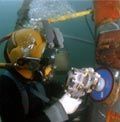
Mark Begbie, Business Development Director of CENSIS takes a look at the challenges facing the North Sea oil and gas industry.
The offshore oil and gas industry is reaching an inflection point. As the oil reserves in shallow waters reach the end of their production lives, operators must take the long view and drill in deeper waters to find new recoverable resources.
Doing this economically presents some significant challenges – a feat which will require serious innovation if firms which grew up with the North Sea are to successfully export their skills.
Using conventional methods is not an option – it’s simply not feasible to place a production rig above a well in water that’s thousands of metres deep. For that reason, the industry is thinking differently about how it works and how it uses technology.
Deep sea exploration is, for many firms, the next frontier. With world class capabilities in sensors, excellence in analytics, and unrivalled expertise in subsea and offshore environments, there is a great deal of existing and relevant skill and knowledge incumbent in Scotland for firms to access.
Sensor technology will undoubtedly play a strategic role in developing these new ways of working. It will enable new approaches to condition monitoring, data gathering and maintenance at depth; the digital subsea paradigm.
Full field subsea processing, where both production and processing equipment is located on the sea floor, is one of the most viable solutions to the challenges ahead. Requiring no surface facilities, subsea processing can potentially extend the lives of mature fields. It could also be the key to unlocking hostile, deep water reservoirs of oil and gas around the world.
Innovation in subsea processing has already delivered the ability to separate water, sand and gas at great depths, enhancing production and expanding the capacity of processing facilities. Separation also enables subsea reinjection to maintain pressure and enhance recovery. Further challenges remain however; not least the ongoing monitoring and maintenance of complex remote plant in inaccessible deep water.
Future, long term monitoring, management and control can only be delivered by autonomous working and the generation of accurate, reliable data from the seabed. Indeed, these facilities will be far away from the weather-dependent maintenance support vessels which could take days to reach them.
Through sensor-based systems the ultimate goal is the ability to monitor this equipment through autonomous underwater vehicles (AUVs) which will be mission-planned and adaptive to structural changes. They will be able analyse risk and distil this information into something actionable – important considerations for anyone looking to operate in these inhospitable conditions.
Sensor and imaging system technology is advancing at a rate of knots, with innovation being exemplified in many other sectors. The key is to recognise the enablers that can be brought to benefit oil and gas. For this to succeed, it will require firms to work with us and articulate the specific challenges they face.
Scotland has the knowledge, skills and expertise which could make subsea processing an economic and effective way of working for many more firms. Now is the time to act and make that potential a reality.
This article appeared in Energy Voice in March 2015